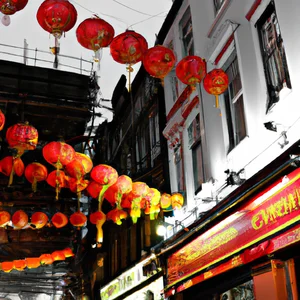Book your experience
East London Food Tour: Street art and street food in the East End
Ah, let’s talk a bit about the food tour I did in East London, which was truly an experience not to be missed! So, imagine walking through the streets of a neighborhood that is like a large illustrated book of street art, with murals that tell life stories, colors that catch the eye and perhaps some profound messages that make you reflect. It’s a bit like entering a movie, but without a script!
And, of course, you can’t forget the street food. Oh, my goodness! I’m just telling you that you could almost smell the delicacies calling out to you. Between one graffiti and another, you come across stalls offering everything: from Mexican tacos that look like they just came out of a fiesta, to Chinese bao that are a real treat for the palate. There’s a place, for example, where they sell falafel that makes you think you’re in a Jerusalem market, and I swear, I’m not even sure how they make them so good!
Not to mention that each dish has its own story. I remember talking to a chef who told me how he started cooking out of passion, and then opened his own kiosk. He was so passionate, that he made me want to get cooking. In short, the atmosphere was super welcoming, as if you were at a friend’s house who is preparing his signature dish for you.
And let’s not talk about desserts! I tasted a dessert that looked like a small masterpiece of art, and it was so good that I could almost say it was the best dessert of my life. Maybe that’s exaggerated, but who knows? Every bite was like a journey into taste heaven.
Let’s say that taking a food tour in the East End is a bit like an adventure in a culinary playground, where every corner hides a surprise and every bite takes you into a new world. Well, if you ever happen to go there, don’t miss the opportunity to immerse yourself in this fusion of art and flavours. I assure you that it is really worth it!
Discover the best of London street food
A journey through flavors and stories
When I first set foot in the markets of London’s East End, an enveloping scent of spices and freshly cooked food hit me like a warm hug. I was strolling along Brick Lane, a thoroughfare pulsating with life and culture, where street vendors offer a variety of dishes that reflect the area’s extraordinary ethnic diversity. Between bites of a delicious Burmese curry and a taste of fresh bagels, I realized that every bite tells a story, a story of traditions that intertwine in the vibrant heart of the East End.
Practical information and insider tips
If you want to discover the best London street food, you can’t miss the weekend at Brick Lane Market, open every Sunday. Here you will find not only culinary delights, but also a unique atmosphere, enriched by live music and street artists. It is estimated that over 2 million visitors flock to this area every year, making it one of the most sought-after culinary destinations in the capital. But little-known advice? Don’t just stop at the busiest stalls; Small vendors along side streets often offer authentic dishes at lower prices.
The cultural impact of street food
Street food in the East End is not just a way to feed yourself, but also represents a meeting of cultures. From Indian restaurants to fish and chip stalls, every dish is a reflection of the community that prepares it. This cultural exchange has historical roots; From the arrival of migrants in the 19th century to the present day, street food has become a symbol of resilience and innovation.
Sustainability and responsibility
Today, many street food vendors are adopting sustainable practices, using local ingredients and reducing waste. For example, the popular vegan burgers vendor “Burger & Beyond” is committed to using organic products and compostable packaging. Choosing to eat here not only supports the local economy, but also contributes to a greener future.
Immerse yourself in the vibrant atmosphere
Imagine walking among the bright colors of the murals that adorn the streets, while the sound of sizzling pans mixes with the chatter of customers. Spitalfields Market awaits you with its culinary delicacies, such as fish tacos, perfect for a quick and tasty lunch. Don’t forget to also enjoy a pork bun at Whitechapel Market; it’s an experience you won’t easily forget.
An activity worth trying
For a unique experience, join a guided food tour that will take you to the best street food stands in the area. Not only will you taste the typical dishes, but you will also have the opportunity to meet the vendors and listen to their stories. Some tours also offer cooking classes, where you can learn to prepare your favorite dishes.
Common myths
A common misconception is that street food is always unhygienic or low quality. In fact, many vendors are passionate chefs who put their hearts into their work, using fresh, high-quality ingredients. Hygiene standards are rigorous and customers can often see the food being prepared.
Final reflection
Every bite of street food in the East End is a journey through intertwining cultures and traditions. I invite you to discover this vibrant part of London and consider how food can tell stories, bring people together and celebrate diversity. What is your favorite street food dish and why?
Iconic murals: art that tells stories
An unexpected encounter
I still remember the moment I came across Banksy’s mural of a girl with a red heart-shaped balloon, overlooking one of the streets of Shoreditch. It was a rainy morning, and as I sought shelter under a porch, the vivid colors of the mural seemed to illuminate the gray London reality. My curiosity pushed me to explore further, and so I discovered that every piece of street art in London is not just an image, but a narrative, a message that invites reflection.
Art in the open air
London is a true open-air museum, where murals tell stories of struggle, hope and culture. Many street artists, such as Stik and Bansky, have transformed forgotten urban spaces into living galleries. For those looking to explore, a stroll around the Shoreditch and Brick Lane neighborhoods is a must. Events like the London Street Art Tour offer local guides who reveal the secrets behind the works, ensuring an authentic and immersive experience.
An insider tip
If you’re looking for a truly unique experience, visit Rich Mix, a cultural center that regularly hosts street art events. Here, you may come across artists in action, creating live works. It’s an opportunity to see the creative process and interact with the emerging talents of the London art scene.
The cultural impact of street art
Over the years, London street art has taken on a significant role as a form of protest and as a means of cultural expression. During social demonstrations, murals have often conveyed messages of justice and change, reflecting the challenges and hopes of local communities. This aspect of street art not only enriches urban aesthetics, but also contributes to an ongoing dialogue about society and its evolution.
Sustainability and art
An important aspect to consider is the environmental impact of the works of art. Many London artists are moving towards sustainable practices, using eco-friendly paints and recycled materials. This approach not only preserves the environment, but also invites visitors to reflect on the importance of sustainability in ours daily.
Immerse yourself in the atmosphere
Walking through the streets of London, let yourself be enveloped by the sounds and colors that surround you. The scent of spices and street food mixes with the music of the markets, creating a vibrant and engaging atmosphere. Every corner, every wall tells a story, and your gaze will get lost in details that speak of a constantly evolving city.
An activity worth trying
For a truly immersive experience, take a street art bike tour. This option will allow you to cover more ground, discovering hidden corners and lesser-known works, while enjoying a dose of exercise. Don’t forget to bring your camera!
Myths to dispel
A common misconception is that street art is just vandalism. In reality, it is a legitimate form of artistic expression that often leads to the enhancement of public spaces and the revitalization of neighborhoods. Many artists are appreciated and invited to create works in official contexts, proving that street art is a recognized art.
Final reflection
London’s street art represents an ongoing dialogue between art, culture and society. I invite you to consider: what story does the mural in front of you tell you? Next time you walk the streets of London, get inspired and ask yourself what message you would like to express.
The hidden markets of the East End
A personal experience among the stalls
I still remember the first time I explored the markets of London’s East End. It was a Saturday morning, the sun was shining and the air was filled with intoxicating aromas. I came across a small market, hidden among the streets of Brick Lane, where vendors offered delicious street food from all corners of the world. I savored an aromatic biryani cooked by a Bangladeshi lady, while a group of street artists colored the scene with their music. It was at that moment that I understood that these markets are not just places of purchase, but real cultural crossroads.
Practical information on the markets
The East End is home to a variety of markets, each with its own unique character. Among the best known are the Brick Lane Market, famous for its vintage and ethnic food stalls, and the Columbia Road Flower Market, an explosion of colors and scents that attracts florists and flower lovers. plant. These markets are open on weekends, but it’s always best to check their specific hours on local websites, such as London Markets.
An insider tip
If you want to discover a lesser-known market, visit Maltby Street Market. Located on a picturesque street, this market is a gem for food lovers, but it’s not as crowded as other more popular spots. Here you can enjoy specialties from small local businesses, such as the delicious cinnamon buns from St. John Bakery, which are a real must for those with a sweet tooth.
Cultural and historical impact
East End markets are not only a reflection of London’s culinary diversity, but also tell stories of immigration and integration. Many of the vendors are members of communities who have found these markets a means to express their culture through food. This cultural exchange is a key part of London’s identity and its unique flavours.
Sustainability and responsibility
Many of these markets are adopting sustainable practices, such as using recyclable materials and supporting local producers. By choosing to eat in these spaces, you not only support the local economy, but you also help reduce the environmental impact of your consumption. It’s a perfect way to explore street food responsibly.
Immerse yourself in the atmosphere
As you stroll through the stalls, let yourself be carried away by the bright colors and sounds of the vendors extolling their delicacies. Imagine the smell of grilled meat, the sound of laughter and music filling the air. Each market has its own soul, and discovering these hidden corners of London is an experience that stimulates all the senses.
An unmissable activity
Don’t miss the opportunity to take a guided food tour of the East End markets. These experiences will lead you to meet the vendors, savor their dishes and discover fascinating stories you might not otherwise hear. It’s a way to connect deeply with the local culture.
Clearing up the myths
It’s common to think that London’s markets are just for tourists, but they actually attract locals too. Many Londoners head to the markets to buy fresh ingredients and enjoy passionately prepared dishes. Don’t be fooled into thinking they’re just tourist traps; here lies the true beating heart of the London culinary scene.
Final reflection
Seen up close, the stories woven across the East End markets offer a unique insight into London life. What story do you expect to discover as you explore these fascinating corners of the city? Let yourself be inspired and ask yourself how food can bring people together and tell the story of different cultures.
Culinary traditions: from fish and chips to curry
A journey through flavors and cultures
I remember the first time I bit into a fish and chips in London: the crunch of the breading crunching under my teeth, the fish tender and steaming, accompanied by a splash of malt vinegar. It was a rainy afternoon, but the flavor of that iconic dish made the atmosphere warm and welcoming. From that moment, I understood that London is not just a capital; it is a crossroads of culinary traditions that tell stories of migration and fusion.
An icon of British cuisine
Fish and chips is much more than a simple dish: it is a symbol of British culture, born in the 19th century and becoming a must on every Londoner’s table. Today, this dish is accompanied by other culinary delights, such as curry, which reflects the great influence of the Indian community in the capital. London boasts one of the highest concentrations of Indian restaurants outside of India, with the famous chicken tikka masala earning the title of ‘Britain’s national dish’.
An insider tip
If you want an authentic experience, I recommend heading to Brick Lane for a traditional Indian curry. This place is famous for its restaurants that offer dishes prepared with recipes passed down from generation to generation. But here’s a secret: before entering a restaurant, look at the menu displayed outside. If you notice that the place has a long line of customers, you are on the right path to an authentic dining experience!
The cultural impact
London’s culinary diversity is not just a matter of flavour, but also of history and culture. The dishes that we now consider part of British tradition are the result of centuries of cultural exchange. Fish and chips and curry represent historical links to the sea and the colonies, which have enriched the British palate and paved the way for new gastronomic experiences.
Sustainability and responsibility
In an age where sustainability is a central theme, many restaurants in London are adopting responsible practices, such as using local and seasonal ingredients. Choosing to eat in places that support local producers is a way to contribute to more sustainable tourism and to discover fresh and authentic flavours.
An experience not to be missed
Don’t miss the chance to join a food tour that will take you to discover the best versions of fish and chips and curry in the city. These tours are often led by local experts who can share fascinating stories about the dishes and their connections to the community.
Myths to dispel
One of the most common myths is that fish and chips should always be served with a generous portion of mashed peas. While this combination is traditional, many restaurants offer more modern and creative variations, such as mushy peas flavored with fresh mint or even vegetarian options.
A personal reflection
As we reflect on London’s culinary traditions, it’s interesting to consider: what dishes from your culture might find a place in such a diverse and vibrant context? Cuisine is a universal language that unites people, and every bite tells a story. What will your food story be in London?
An alternative tour: street art and bikes
A personal experience
The first time I explored the streets of London by bicycle, my heart was pounding with excitement. The wheels rolled on the asphalt as I entered the alleys of the East End, a corner of the city that tells stories of resistance and creativity. I remember stopping by a Banksy mural, where a group of kids were taking selfies. In that moment, I realized how powerful street art was: not just an artistic expression, but a truly living dialogue between artists and the community.
Practical information
For those who want to undertake an alternative tour to discover London street art, there are several options. Several companies, such as London Cycle Tours, offer guided itineraries that combine street art with the discovery of lesser-known areas. The tours, which last approximately 3 hours, depart from different locations in the city center and head towards neighborhoods full of murals, such as Shoreditch and Brick Lane. It is advisable to book in advance, especially on weekends, to secure a place.
An insider tip
An insider trick for an even more authentic experience? Bring a camera with you and try to capture not only the murals, but also the artists at work. Many of them are happy to share their story and techniques. Also, don’t forget to stop by one of the many cafes serving local street food, such as the famous bacon sandwich, for a tasty break!
Cultural and historical impact
Street art in London is not just decorative; it is a means of social and political expression. Artists like Banksy and Shepard Fairey have used street art to address global issues, from human rights to environmental crises. This art form emerged in the 1980s and transformed the way Londoners perceive public spaces, making them more inclusive and accessible.
Sustainability in tourism
Considering the growing focus on sustainable tourism, exploring London by bike is an eco-friendly choice. Help reduce the environmental impact and discover the city from a new perspective. Several bike rental companies, such as Boris Bikes, offer low-cost, easy-to-use options, making the experience even more accessible.
Immerse yourself in the local atmosphere
Imagine cycling along the red brick streets, immersed in the scent of curry and spices wafting from the kiosks. Every corner is a work of art, every graffiti tells a story. Bicycles allow you to approach these works without haste, enjoying every detail and discovering hidden corners that you might miss on foot.
Activities to try
Don’t miss the opportunity to participate in a street art workshop. Many local artists offer hands-on sessions where you can learn to create your own mural. This will not only allow you to express your creativity, but will also connect you with the local art community.
Myths and misconceptions
A common myth is that street art is synonymous with vandalism. In reality, many artists work with the consent of building owners and contribute to redeveloping abandoned spaces. This art form is a celebration of creativity and a way to beautify the city.
Final reflection
Next time you think of London, think of it not just as a historic capital, but as an open-air art gallery. What message would you like your personal mural to convey? Street art has the power to inspire and provoke reflection; it’s time to join this urban dialogue.
Sustainability in food: where to eat responsibly
A journey into taste and responsibility
When I first found myself in Brick Lane, surrounded by an explosion of flavors and aromas, I never thought I would discover a world of sustainable food. I was enjoying a delicious biryani, when the stall owner told me how each ingredient was carefully chosen, sourced from local suppliers who practice responsible cultivation methods. It was in that moment that I realized how impactful the way we eat can be.
Where to find sustainable food in London
London offers several places where the food is not only good, but also responsible. Markets like Borough Market not only boast a wide range of fresh produce, but many of the vendors are committed to using organic ingredients and reducing waste. Other examples include restaurants like Manna and Mildreds, which are pioneers in plant-based and sustainable cuisine, offering dishes that not only fill you up, but also respect the environment.
An insider tip
If you want an authentic experience, look for pop-up dinner events hosted by local chefs who are dedicated to sustainability. These events not only offer a delicious meal, but also the opportunity to learn about the producers and the stories behind the ingredients. Often, you can find information about these events on social media or through platforms like Eventbrite.
The cultural importance of sustainable food
The growing focus on food sustainability in London reflects a wider cultural shift. The city, historically a crossroads of cultures and culinary traditions, is now embracing more responsible food practices, which influence consumption habits and the way restaurateurs approach cooking. Awareness of how food is produced and consumed is becoming an integral part of London life.
Responsible tourism practices
If you want to travel responsibly, consider choosing restaurants that partner with local producers and reduce their use of plastic. Additionally, many street food kiosks adopt sustainable practices, such as using compostable tableware and recycling materials. This not only helps preserve the environment, but also allows you to enjoy authentic and fresh dishes.
An experience not to be missed
I recommend booking a food tour that focuses on sustainability. Many of these tours will take you to discover local restaurants and markets that make responsibility a priority. It’s an engaging way to explore the city while savoring delicious dishes.
Dispelling the myths
There is a belief that sustainable food is always expensive or cannot be tasty. In fact, there are many options that offer delicious dishes at affordable prices, proving that eating responsibly doesn’t mean compromising on taste.
A final reflection
Visiting London is an opportunity not only to explore its history and culture, but also to reflect on our role in promoting sustainable food practices. The next time you choose a restaurant or kiosk, ask yourself: how can my food choices make a difference?
Street food and culture: a unique fusion
An anecdote that tells a story
Walking through the lively streets of Camden Market, I found myself in front of a stall selling bánh mì, a Vietnamese sandwich. The smell of crunchy bread and fresh herbs struck me immediately. Chatting with the owner, a young man of Vietnamese origin, I discovered that his kiosk is not just a place to sell food: it is a bridge between cultures. Each sandwich contains a story of migration and integration, a microcosm of multicultural London.
Practical and up-to-date information
London street food is an ever-evolving phenomenon. Markets such as Borough, Brick Lane and Southbank offer a wide range of culinary options, from local delicacies to international dishes. According to the Street Food London website, there are over 150 active street food markets in the capital, with events taking place almost every day. Don’t forget to check social media for the latest emerging kiosks and trendiest pop-ups.
An insider tip
If you want a truly authentic experience, look for “secret supper clubs” that take place in private homes. These events offer traditional dishes and family recipes, often inspired by cuisines from around the world, and allow you to mingle with locals in an intimate setting. Some of the best-known clubs include The Secret Larder and The Cook and the Chef; book in advance, as places are limited.
Cultural and historical impact
Street food in London is a reflection of its history. Over the years, the city has become a crossroads of cultures, where street food has taken different forms, from classic fish and chips to Mexican tacos. Each dish tells a story of ethnic influences and culinary traditions, making street food not just a meal, but a cultural experience.
Sustainable tourism practices
Choosing to eat street food can also be a responsible choice. Many vendors are committed to sustainable practices, using local ingredients and minimizing waste. Markets like Borough Market offer organic and artisanal food options, allowing visitors to enjoy delicious dishes without compromising the planet.
A lively and engaging atmosphere
Imagine walking down a crowded street, surrounded by bright colors and festive sounds. The scents of spices mix in the air, as locals and tourists mingle in a dance of cultures. Every bite of a steamed baozi or crispy falafel transports you on a unique sensory journey, where food becomes the universal language that unites people.
An activity worth trying
For an immersive experience, take a street food tour. There are several options available, such as Eating London Tours, which guide you through the best street food spots in the East End, giving you tastes and the stories behind each dish. This is a fantastic way to explore the city while satisfying your appetite.
Myths and misconceptions
A common misconception is that street food is always unhygienic or low quality. In fact, many street food vendors are renowned chefs who choose to bring their culinary art directly to the streets. The quality of ingredients and creativity are often astonishing, and many of London’s best restaurants started out as street food kiosks.
A final reflection
Next time you are in London, ask yourself: what stories are hidden behind the dishes you taste? Every bite of street food is an invitation to discover not only different flavors, but also cultures and traditions that enrich our travel experience. Are you ready to be surprised by the unique fusion of street food and London culture?
Historical heritage: the origins of street food
When I first set foot in vibrant East London, the enveloping scent of street food immediately captured my senses. I vividly remember an evening spent in Brick Lane, where a small biryani stall caught my attention. As the chef mixed fragrant rice with exotic spices, I felt the pull of the stories contained in each dish. In that moment, I understood that street food is not just a quick meal: it is a journey through time that connects us to the different cultures that have shaped this neighborhood.
The historical roots of street food
London’s East End has a rich and varied culinary history, rooted in the traditions of migrants who found refuge and opportunity in this part of the city. From the historic fish and chips, symbol of British cuisine, to Indian curry, which conquered the palates of the English, each dish tells a story of adaptation and innovation. According to an article published by Time Out London, street food has become a way to preserve culinary traditions, allowing chefs of different origins to share their culture through food.
An insider tip
If you want an authentic experience, don’t limit yourself to the busiest kiosks. Discover small street markets, such as Mile End Market, where local vendors offer traditional dishes at affordable prices. Here you might come across a delicious jollof rice, a Nigerian dish that has become a must for anyone visiting the area.
The cultural impact
Street food in East London is not only a way to feed yourself, but also a vehicle for intercultural communication. Every bite is an opportunity to learn about another culture, a practice that promotes integration and acceptance. The ethnic cuisines that mix in the markets and kiosks are a reflection of the diversity that characterizes the neighborhood.
Sustainability and responsible tourism
Many street food vendors are embracing sustainable practices, using local ingredients and reducing waste. Choosing to eat at these places not only supports local communities, but also contributes to a greener economy. Be sure to ask about local suppliers and the sustainability practices adopted by the sellers.
An invitation to explore
If you’re ready to immerse yourself in this culinary experience, don’t miss the chance to join a guided street food tour, like the one offered by Eat and Walk London. These tours will take you to lesser-known spots in the East End, where you can savor unique dishes and hear the stories behind every bite.
Myths and misconceptions
A common misconception is that street food is always unhealthy or of poor quality. In fact, many vendors are dedicated to preparing fresh and nutritious dishes, using wholesome ingredients and traditional recipes. The key is to pay attention to where you eat and choose operators who value quality.
In conclusion, the street food of London’s East End is much more than just a quick meal option. It is a living cultural heritage that invites you to explore unique stories, traditions and flavours. What dish would you like to try to discover more about the history of this fascinating neighborhood?
Taste the East End: typical dishes to try
Walking the lively streets of London’s East End, the scent of street food has always drawn me like a magnet. I remember one time in particular, while exploring Brick Lane, the beating heart of the local culinary scene. While wandering among the kiosks, I was lucky enough to come across a seller of jalebi, that fried Indian dessert soaked in sugar syrup. The sweet and spicy smell was so enveloping that I couldn’t resist. Each bite was an explosion of flavors that told a story of tradition and culture.
Dishes not to be missed
When we talk about typical East End dishes, there are some real gastronomic institutions that you can’t miss:
Fish and Chips: You can’t talk about London without mentioning this classic. Here, the fish is often caught fresh, and the chips are crispy and golden. Try the Poppies Fish & Chips, which has retained its vintage charm and offers impeccable service.
Biryani: The East End is also home to a large Bengali community, and biryani is one of the specialties to savour. I recommend you visit Brick Lane Beigel Bake for an authentic experience.
Pie and Mash: This traditional dish, made up of savory pie and mashed potatoes, is a must. Experience the original from M. Beef, where the secret lies in the rich filling and green sauce.
An insider tip
If you really want to immerse yourself in the food culture of the East End, don’t limit yourself to the most famous food stalls. Look for pop-ups and food trucks at local markets on the weekend. These spaces offer a variety of innovative and fresh dishes, often created by emerging chefs. This is where you can find authentic culinary fusions, like the Korean BBQ Burger, which combines the best of Korean and American cuisine.
Cultural and historical impact
Street food in the East End is much more than a quick meal; represents a melting pot of cultures and traditions. The mix of influences is the result of decades of immigration, making the gastronomy of this neighborhood a reflection of its history. Each dish tells a story of people, places and passions, creating a deep connection between food and community.
Sustainability in food
In an age where sustainability is key, many street food vendors are adopting responsible practices. Look for kiosks that use local, seasonal ingredients, or that offer vegetarian and vegan options. This not only supports the local economy, but also reduces environmental impact.
An experience worth trying
To make your visit even more memorable, take a guided food tour. These tours will not only take you to discover the best kiosks and restaurants, but will also give you the opportunity to meet locals and listen to their stories. It’s a fantastic way to learn more about the culture and culinary tradition of the East End.
Myths to dispel
A common misconception is that street food is always substandard or unhygienic. In fact, many sellers are passionate craftsmen who are dedicated to offering high-quality products. Don’t let appearances fool you: street food here is often prepared with fresh, top-quality ingredients.
Final reflection
After tasting typical East End dishes, you feel enriched by an experience that goes beyond simply eating. It is a journey through flavors and stories that invites a deeper reflection on cultural diversity. What East End dish are you most excited to try?
Meet the locals: authentic stories and recipes
An anecdote that talks about connections
I still remember my first visit to a small street food market in Brick Lane, where the air was permeated with the scents of spices and freshly baked pastries. As I savored a delicious lentil curry, an elderly gentleman, with a smile lighting up his face, approached me and began telling me the story of his family, who had run the stand for generations. That personal connection, along with the food, made me realize how important the stories behind each dish are.
Practical information
To discover the beating heart of London’s gastronomic culture, I recommend you visit the street food events organized in the city’s various markets, such as Borough Market and Street Feast. These places are not only great for enjoying local dishes, but also for meeting the producers and listening to their stories. You can find up-to-date event information on the Street Feast website or Time Out London.
An insider tip
A little-known tip: don’t forget to look for small stalls that don’t have a written menu, but are famous among locals. Often, these are the best for enjoying authentic dishes and discovering recipes passed down from generation to generation. One example is a small stall in Camden that serves a chicken tikka roll which has a history dating back to the 1980s.
The cultural impact of street cuisine
Street food in London is not just a way to eat, but is also a reflection of the city’s multiculturalism. Each dish tells a story of migration, of traditions that merge and of cultures that meet. Curry, for example, has become an iconic British dish, thanks to the influence of the Indian and Pakistani communities who have enriched London’s culinary landscape.
Sustainability and responsible food
An increasingly important aspect is sustainability in street food. Many street food vendors in London are adopting more responsible practices, using local and sustainable ingredients. Look for vendors that use biodegradable materials for their packaging or that offer vegetarian and vegan options.
An immersive experience
Imagine strolling along the busy streets, the sound of laughter and conversation surrounding you, as you tuck into a freshly cooked pork bun. Every bite is a journey into London’s history, a mix of tradition and innovation that makes the city’s food scene so compelling.
Activities to try
I recommend taking a guided food tour, such as those offered by Eating London Tours, where you will have the opportunity to taste authentic dishes and listen to the stories of the locals. These experiences not only satisfy the palate, but also enrich your understanding of London culture.
Myths and misconceptions
Street food is often thought to be synonymous with junk food, but in reality it offers a unique opportunity to discover authentic recipes and fresh ingredients. Many vendors are committed to maintaining high standards of quality and hygiene, so don’t hesitate to explore these dining options.
A final reflection
What’s the story behind your favorite dish? Next time you tuck into street food in London, take a moment to consider not just the flavour, but also the stories and traditions that make every bite a unique experience. Let yourself be involved in the locals’ narratives and discover how food can bring people together, creating bonds and unforgettable memories.

 Architecture and Design
Architecture and Design Cities and Regions
Cities and Regions Culture and History
Culture and History Events and Festivals
Events and Festivals Fashion and Shopping
Fashion and Shopping Food and Wine
Food and Wine Nature and Adventure
Nature and Adventure Unique Experiences
Unique Experiences



























